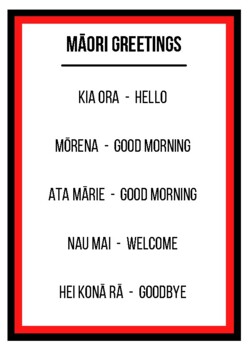Embrace Te Reo: The Joyful Guide to Saying Hello in Maori for Parents and Kids
Greetings, wonderful parents! Are you looking to introduce your precious little ones to the rich cultural tapestry of Aotearoa (New Zealand)? What better way to start than by learning the Maori word for hello? This guide is specially crafted to help you and your children embark on a delightful journey into Te Reo Maori—the indigenous language of New Zealand. With a dash of fun, a sprinkle of culture, and heaps of easy-to-follow steps, you’re about to make “hello” much more than just a greeting!
The Magic of ‘Kia Ora’ – A Universal Maori Greeting
Let’s dive into the vibrant essence of Maori greetings – starting with the famous ‘Kia Ora’! Literally translating to ‘be well/healthy’, this phrase is synonymous with good vibes and happy hellos. While it’s a commonplace phrase throughout New Zealand, ‘Kia Ora’ carries significant weight in expressing warmth and genuine care in Maori culture.
- Kia Ora – A friendly and informal way to say hello to one person or many!
- Kia Ora koutou – Have more than one person to greet? This is the phrase for you, suitable for greeting three or more people.
- Kia Ora r? – Seeking a slightly more formal tone or wanting to wish someone well for the day? Use ‘Kia Ora r?.’
Encouraging your children to use ‘Kia Ora’ helps them understand the importance of greetings and connects them with the spirit of Maori culture, even from a young age.
More Than Hello: Learning Common Maori Greetings
Beyond ‘Kia Ora’, Te Reo Maori has an array of greetings that can fit different contexts and times of the day. Let’s look at how you can expand your family’s vocabulary to share the joy of speaking Maori all day long!
- Ata m?rie – Bright morning! This is a beautiful way to say good morning and invoke the freshness of a new day.
- T?n? koe – This is a respectful way of saying hello to one person, much like ‘hello sir/ma’am’ in English.
- T?n? koutou – This phrase extends respect to greet a group of people.
- T?n? k?rua – When addressing two people, use this version to maintain the same level of respect.
- Haere mai – Welcome! Trying to make someone feel at home? Use ‘Haere mai’ to invite them into your space, whether it’s your home or a meeting.
- P? m?rie – A serene way to say good night. Just perfect for bedtime stories and tucking in your little ones.
Treating these phrases like a fun game will not only make learning enjoyable for your kids but also instill a sense of pride and connection to New Zealand’s heritage.
The “Why” Behind the Greetings: Instilling Cultural Values
Understanding the ‘why’ is just as essential as mastering the ‘how’. When you teach your children to say hello in Maori, you are giving them much more than words. You’re giving them the key to an inclusive society, showing them how to pay homage to indigenous culture, and setting an example of cultural respect and appreciation.
By using Te Reo in daily life, we not only keep the language thriving but also contribute to the nurturing environment that respects diversity, encourages learning, and fosters curiosity. It’s an excellent opportunity for your family to bond over learning something new while giving your children the tools they need to be worldly citizens.
Talking about the importance of Maori greetings and the stories behind them can make the learning journey rich and memorable. After all, every ‘Kia Ora’ is more than a ‘hello’; it’s an echo of New Zealand’s soul, inviting us all to embrace the unique Maori heritage.
So, let’s continue to weave these beautiful strands of language and culture into the tapestry of your family life. By doing so, you help ensure the vibrancy of Te Reo Maori is shared, celebrated, and cherished for generations to come.
The Next Step: Practicing Te Reo at Home and Beyond
With the basics of Maori greetings under your belt, the next step is to practice, practice, and practice some more! Make it a routine at home, perhaps greeting each other in Maori during breakfast or before bedtime. Connect with community groups, or integrate Te Reo Maori books and songs into your daily activities. Every little step contributes to fluency and confidence in using the language.
And remember, languages are living things – they grow and evolve with every conversation. Your family’s journey with Te Reo Maori is sure to be filled with laughter, learning, and lots of love. Kia kaha (be strong)! Keep encouraging each other, and make every ‘hello’ count!
Thank you for taking this first step into the world of Maori greetings with us. Stay with us as we explore more about Te Reo, and let’s make every greeting an opportunity to weave cultural diversity into the fabric of our children’s lives. Happy learning, and as always, Kia Ora!

Five Things Parents Should Know in Preparing for ‘Hello’ in Maori
Embarking on this journey requires a vigilant and warm approach. Here are five key things to consider as you and your children step into the world of Maori greetings:
- Respect the Language’s Cultural Significance: Recognize that Te Reo Maori is not just a means of communication but a vital part of New Zealand’s heritage. Teaching your kids about the traditions associated with the language enhances the learning experience and respect for the Maori culture.
- Start with the Basics and Be Consistent: Utilize everyday opportunities to practice greetings in Te Reo. Consistency helps embed the language naturally into your children’s vocabulary. Simple phrases like ‘Kia Ora’ can be a great start to this enriching habit.
- Engage with Authentic Maori Resources: From children’s books to music, there are plenty of resources available that can make learning fun and authentic. Seek out Maori cultural events or groups that you and your family can participate in to further immerse yourselves in the language.
- Make Use of Technology and Apps: In our digital age, there are interactive apps designed to make learning Te Reo engaging for young minds. These tools can supplement your child’s learning and provide a convenient method to practice new phrases.
- Encourage Questions and Curiosity: Children are naturally curious. Encourage them to ask questions about the language and its cultural background. Seek the answers together, fostering a deeper understanding and interest in Te Reo Maori.
Incorporating these steps will create a supportive environment that celebrates the Maori language while contributing to a sense of global citizenship in your children. The journey of learning Te Reo Maori is not only about adding new words to your family’s vocabulary but also about connecting with the heart and history of Aotearoa.
Bringing It All Together: Your At-Home Maori Language Plan
Creating a clear plan for integrating Te Reo into your home can set the foundation for a successful and joyful learning experience. Here are some tips to get you started:
- Use Labels Around the House: Label everyday objects with their Maori names. This visual reinforcement accelerates learning and makes using Te Reo a natural part of household conversations.
- Set Language Goals: Having goals, such as learning a new phrase or song each week, keeps the process structured and rewarding. Celebrate achievements together to motivate continued learning!
- Create a Maori Language Corner: Dedicate a space in your home where Te Reo resources are easily accessible. Fill it with books, flashcards, and other materials that encourage spontaneous learning.
- Incorporate Te Reo in Daily Routines: Whether it’s saying good morning or good night, set specific times of the day for using Maori greetings. This routine helps cement new language habits.
- Join a Community of Learners: Connect with local or online communities that focus on learning Te Reo. Not only does this provide moral support, but it also exposes your family to different accents and dialects within the language.
The path to learning Te Reo Maori is as rich and rewarding as the language itself. With each phrase and each greeting, you’re gifting your children a precious cultural gem and nurturing an inclusive global view. Get ready to add joy, laughter, and a whole lot of ‘Kia Ora’ to your family’s everyday life!
See more great Things to Do with Kids in New Zealand here. For more information see here
Disclaimer
The articles available via our website provide general information only and we strongly urge readers to exercise caution and conduct their own thorough research and fact-checking. The information presented should not be taken as absolute truth, and, to the maximum extent permitted by law, we will not be held liable for any inaccuracies or errors in the content. It is essential for individuals to independently verify and validate the information before making any decisions or taking any actions based on the articles.




